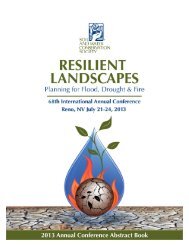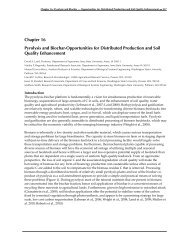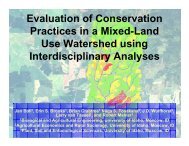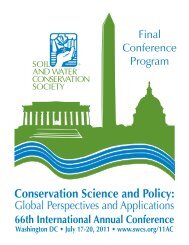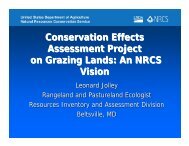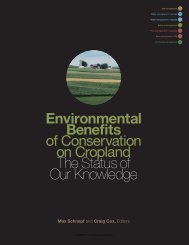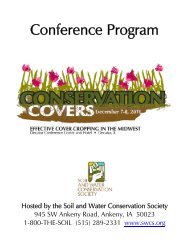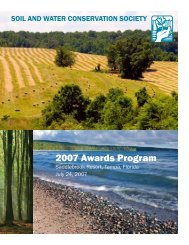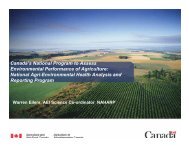Yuan, Yongping - Soil and Water Conservation Society
Yuan, Yongping - Soil and Water Conservation Society
Yuan, Yongping - Soil and Water Conservation Society
Create successful ePaper yourself
Turn your PDF publications into a flip-book with our unique Google optimized e-Paper software.
ANNAGNPS APPLICATION FOR BEASLEY<br />
LAKE WATERSHED CONSERVATION<br />
PRACTICES ASSESSMENT<br />
USDA-ARS-National Sedimentation Laboratory<br />
<strong>Yongping</strong> <strong>Yuan</strong>, Martin Locke, Ron Bingner
Introduction<br />
• The impairment of water quality from<br />
nonpoint source pollution continues to be a<br />
societal <strong>and</strong> environmental concern.<br />
• To address nonpoint source pollution<br />
problems, the USEPA m<strong>and</strong>ates states to<br />
develop TMDLs <strong>and</strong> the NRCS promotes<br />
conservation practices <strong>and</strong>/or BMPs.<br />
• In 2003, the USDA began implementing the<br />
<strong>Conservation</strong> Effect Assessment Project<br />
(CEAP).
Objectives of CEAP<br />
• The principal focus of the CEAP is to assess<br />
environmental benefits derived from implementing<br />
USDA conservation programs supported by the<br />
USDA in the 2002 Farm Bill.<br />
• <strong>Water</strong>shed Assessment Studies (WAS) are a key<br />
element of the CEAP.<br />
• One of the CEAP-WAS goals is to utilize models to<br />
simulate environmental effects of conservation<br />
practices <strong>and</strong> evaluate the capabilities of<br />
watershed models to assess the effect of USDA<br />
conservation practices.
CEAP Study <strong>Water</strong>sheds<br />
Fourteen ARS maintained benchmark watersheds representing different<br />
agroecosystems were selected across the country for the CEAP project
Beasley Lake <strong>Water</strong>shed<br />
• Beasley Lake watershed was originally one of the<br />
three watersheds studied in the Management<br />
Systems Evaluation Area project (MSEA), which<br />
sought to develop <strong>and</strong> assess alternative<br />
innovative farming systems for improved water<br />
quality.<br />
• Beasley Lake <strong>Water</strong>shed is unique in that it<br />
represents the large portion of the Mississippi<br />
Delta cotton-soybean production fields that<br />
produce a significant amount of sediment.<br />
• Beasley Lake is an oxbow lake cutoff from the<br />
Sunflower River.
Sunflower River Beasley Lake Forest Area
<strong>Water</strong>shed Characteristics<br />
• The total drainage area of the BLW is<br />
approximately 850 ha, <strong>and</strong> the lake area is<br />
approximately 25 ha.<br />
• The watershed topography is very flat, with a 5 m<br />
difference in elevation from the top of the<br />
watershed boundary to the lake surface.<br />
• The watershed is a relatively closed system.<br />
• <strong>Soil</strong> texture in the watershed varies from s<strong>and</strong>y<br />
loam to heavy clay.
<strong>Water</strong>shed Characteristics<br />
• Prior to 1995, conventional tillage was the<br />
dominant practice applied to the watershed.<br />
• Since its inclusion in the MDMSEA project in 1995,<br />
reduced–tillage cotton, no–tillage soybeans <strong>and</strong><br />
edge-of-field practices were implemented.<br />
• In 1995–1996, the U.S. Geological Survey (USGS)<br />
installed a gauging station to monitor runoff,<br />
sediment, nutrient <strong>and</strong> pesticide loadings at one of<br />
the inlets to the Beasley Lake.
<strong>Water</strong>shed Characteristics<br />
• From 1995 to 2002, 660 ha of the watershed were<br />
cropped with cotton, corn <strong>and</strong> soybeans, <strong>and</strong><br />
cotton represented about 70% of total cropped<br />
area.<br />
• From 2003 to present, soybeans have been the<br />
dominant crop (more than 50%), but cotton, corn,<br />
<strong>and</strong> sorghum are also produced.<br />
• From 2003, 91 ha were removed from crop<br />
production <strong>and</strong> planted into native grass <strong>and</strong><br />
hardwoods under the <strong>Conservation</strong> Reserve<br />
Program (CRP).
AnnAGNPS<br />
• Annualized Agricultural Non-Point Source pollutant<br />
loading (PL) model.<br />
• Continuous simulation, watershed scale model.<br />
• Simulates water, sediment, & chemical loadings.<br />
• Can be used in gaged & ungaged, agriculturalrelated<br />
watersheds containing mixed l<strong>and</strong> use.<br />
• Tracks loadings by source throughout the<br />
transport process.
AnnAGNPS:<br />
Processes<br />
Uses NRCS St<strong>and</strong>ards<br />
Databases<br />
• Weather Generation - GEM<br />
• Runoff – SCS Curve Number<br />
• Peak Runoff – TR-55<br />
• Erosion - RUSLE<br />
• Nutrients (N, P <strong>and</strong> C)<br />
• Pesticides<br />
• <strong>Soil</strong>s - NASIS<br />
• Crops <strong>and</strong> Operations –<br />
Set by NRCS State<br />
Agronomists<br />
• HUWQ Databases –<br />
Fertilizer, Pesticides,<br />
Animal Wastes, etc.
Data Requirements<br />
<strong>Soil</strong> Data<br />
Cell Processes<br />
runoff event<br />
Reach<br />
Topographic<br />
Field Management<br />
Climate<br />
Agricultural<br />
L<strong>and</strong>use (crops)<br />
Management<br />
Schedule<br />
Non-Agricultural<br />
L<strong>and</strong>use<br />
Fertilizers<br />
Irrigation<br />
Pesticides<br />
SCS CN
All Available AnnAGNPS Input Data Sections<br />
AnnAGNPS<br />
Identifier<br />
<strong>Water</strong>shed<br />
Data<br />
Simulation<br />
Period<br />
Daily<br />
Climate<br />
Verification<br />
Data<br />
Global<br />
Output<br />
Gully<br />
Point<br />
Source<br />
Feedlot<br />
Feedlot<br />
Management<br />
Field Pond<br />
Cell Data<br />
Reach Data<br />
<strong>Soil</strong>s<br />
Management<br />
Field<br />
Tile-Drain<br />
Impoundment<br />
Reach Channel<br />
Geometry<br />
Reach Nutrient<br />
Half-life<br />
Management<br />
Schedule<br />
Fertilizer<br />
Application<br />
Pesticides<br />
Application<br />
Management<br />
Operation<br />
Strip Crop Contours Crop Runoff Curve<br />
Number<br />
Irrigation<br />
Fertilizer<br />
Reference<br />
Pesticides<br />
Reference<br />
Non-Crop<br />
Required<br />
Required if Referenced<br />
Optional
AnnAGNPS: Output<br />
Average annual contribution of each cell’s unitarea<br />
loads to the outlet as well as by individual<br />
event are available such as:<br />
• sediment & chemical (nutrients <strong>and</strong> pesticides)<br />
pollutants;<br />
• yield of all constituents (water, sediment, &<br />
chemicals) to its receiving stream;<br />
• loading of all constituents at any location in the<br />
stream network; <strong>and</strong>
Data Requirements<br />
• Various GIS data layers of the watershed<br />
including DEM, l<strong>and</strong>-use, <strong>and</strong> soils.<br />
• In field crop operation <strong>and</strong> management.<br />
• Climate information.
Data Collections<br />
• Elevation was obtained by GPS survey from 2005-2006.<br />
• <strong>Soil</strong> survey was conducted by the NRCS district office in<br />
spring of 2006.<br />
• From 1996 to 2003, detailed records have been kept of<br />
field management operations, including crop, planting<br />
dates, fertilizer <strong>and</strong> pesticide applications, cultivation<br />
events, <strong>and</strong> harvest dates.<br />
• From 1996 to 1999, maximum <strong>and</strong> minimum temperatures,<br />
precipitation <strong>and</strong> wind speed were recorded at the<br />
Stoneville which is about 15 miles away from Beasley<br />
Lake watershed. From 2000 to 2005, maximum <strong>and</strong><br />
minimum temperatures, precipitation <strong>and</strong> wind speed<br />
were recorded at the Beasley Lake watershed.
Annual Average <strong>Soil</strong> Erosion from 1996-2003<br />
Average Annual <strong>Soil</strong> Erosion from 1996 to 2003 (Mg/ha.)<br />
0.045 - 0.108<br />
0.108 - 1.565<br />
1.565 - 2.231<br />
2.231 - 2.395<br />
2.395 - 3.235<br />
3.235 - 3.816<br />
3.816 - 5.764<br />
5.764 - 7.386<br />
7.386 - 8.326
ID<br />
A<br />
B<br />
C<br />
D<br />
E<br />
F<br />
G<br />
H<br />
I<br />
J<br />
K<br />
L<br />
M<br />
N<br />
Scenario<br />
Description<br />
Existing (baseline) condition<br />
7% of the watershed representing the highest eroding cropl<strong>and</strong> areas (60.3 ha.) converted to no-till<br />
soybeans<br />
17% of the watershed converted to no-till soybeans<br />
33% of the watershed converted to no-till soybeans<br />
All cropl<strong>and</strong> no-tilled soybeans<br />
All cropl<strong>and</strong> reduced tillage Soybean<br />
All cropl<strong>and</strong> conventional tillage Soybean<br />
All cropl<strong>and</strong> conventional tillage cotton<br />
All cropl<strong>and</strong> reduced tillage cotton<br />
All cropl<strong>and</strong> no-tilled cotton<br />
7% of the watershed representing the highest eroding cropl<strong>and</strong> areas (60.3 ha.) converted to grass l<strong>and</strong><br />
17% of the watershed representing the highest eroding cropl<strong>and</strong> areas (143.8 ha.) converted to grass<br />
l<strong>and</strong><br />
33% of the watershed representing the highest eroding cropl<strong>and</strong> areas (281.2 ha.) converted to grass<br />
l<strong>and</strong><br />
All cropl<strong>and</strong> converted to grass l<strong>and</strong>
Comparison of results from alternative scenarios<br />
L<strong>and</strong>scape Erosion/Sediment Load/Sediment Yield (T/ha/year)<br />
3.5<br />
3.0<br />
2.5<br />
2.0<br />
1.5<br />
1.0<br />
0.5<br />
0.0<br />
L<strong>and</strong>scape soil erosion<br />
Sediment yield<br />
Sediment load<br />
A B C D E F G H I J K L M N<br />
Scenario<br />
A. Existing (baseline) condition.<br />
B 7% of the watershed representing<br />
the highest eroding cropl<strong>and</strong> areas<br />
(60.3 ha.) converted to no-till<br />
soybean.<br />
C 17% of the watershed (143.8 ha.)<br />
converted no-till soybeans.<br />
D 33% of the watershed (281.2 ha.)<br />
converted to no-till soybeans.<br />
E All cropl<strong>and</strong> no-tilled soybeans.<br />
F All cropl<strong>and</strong> reduced tillage<br />
Soybean.<br />
G All cropl<strong>and</strong> conventional tillage<br />
Soybean.<br />
H All cropl<strong>and</strong> conventional tillage<br />
cotton.<br />
I All cropl<strong>and</strong> reduced tillage cotton.<br />
J All cropl<strong>and</strong> no-tilled cotton.<br />
K 7% of the watershed representing<br />
the highest eroding cropl<strong>and</strong> areas<br />
(60.3 ha.) converted to grass l<strong>and</strong>.<br />
L 17% of the watershed representing<br />
the highest eroding cropl<strong>and</strong> areas<br />
(143.8 ha.) converted to grass l<strong>and</strong>.<br />
M 33% of the watershed representing<br />
the highest eroding cropl<strong>and</strong> areas<br />
(281.2 ha.) converted to grass l<strong>and</strong>.<br />
N All cropl<strong>and</strong> converted to grass<br />
l<strong>and</strong>.
Conclusions<br />
• The model demonstrated that applications of<br />
various areas of no-tillage or grassl<strong>and</strong> to the<br />
watershed could reduce sediment loadings to a<br />
range of 15-69 percent of the existing condition.<br />
• Converting 7% of the highest eroding cropl<strong>and</strong><br />
cells to no tillage soybean practice would reduce<br />
sediment load by 15%.<br />
• A more efficient way is to convert the 7% of the<br />
highest eroding cropl<strong>and</strong> cells to grass that would<br />
reduce sediment load by 19%.
Conclusions<br />
• For the same tillage system, planting soybeans<br />
resulted in less sediment loading to the lake than<br />
planting cotton because soybeans produces more<br />
residue that provides a better protection of the soil<br />
than cotton.<br />
• Converting all the cropl<strong>and</strong> to no-tillage soybeans<br />
would reduce sediment loading by 77%; whereas<br />
converting all the cropl<strong>and</strong> to no-tillage cotton<br />
would reduce sediment loading by 64%.
Future Work<br />
• Linking AnnAGNPS model with a lake water<br />
quality model <strong>and</strong>/or establish links<br />
between sediment load <strong>and</strong> biologic<br />
impairment/aquatic habitat of the Beasley<br />
Lake watershed will be one of the future<br />
enhancements of AnnAGNPS.
Acknowledgements<br />
• Special thanks go to John Massey <strong>and</strong><br />
Calvin Vick for their field data collection.



